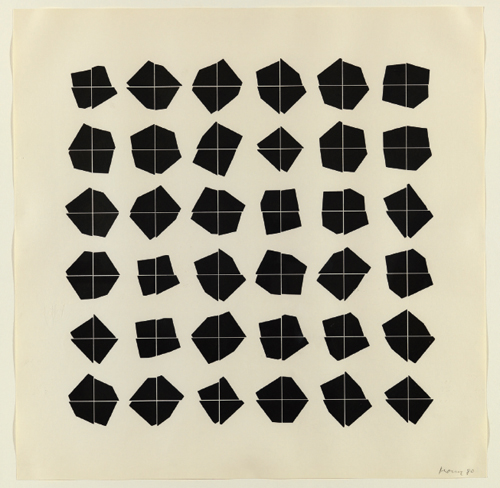The Algorists
By Anna Lena Phillips
An exhibit of early digital art encourages viewers to explore the history of new media
An exhibit of early digital art encourages viewers to explore the history of new media

DOI: 10.1511/2011.89.126
An elliptical path of light, composed of regularly spaced dots, interrupts the deep black of a photograph. It spirals around itself, making a shape reminiscent of beating wings or a dancer’s moving arm. But this abstract composition, by Ben Laposky and dated circa 1952, has a concrete origin: It’s a time-lapse exposure of an oscilloscope’s screen.
The photograph is the earliest example of computer art in a current exhibit focused on early computer art. “Drawing with Code,” at the DeCordova Sculpture Park and Museum in Lincoln, Massachusetts, runs from January 29 to April 24 and includes visual art by more than 20 artists, along with a few examples of animation art. The show includes recent works but its emphasis is these initial—and often overlooked—experiments in using computer technology for artistic purposes.
“Many of these original people were either programmers or mathematicians enamored with what they could do visually with computers,” says George Fifield, the curator of the show, a professor in the Digital + Media department at Rhode Island School of Design, and director of the Boston Cyberarts Festival. The artists used old machinery—a bombsight, in one case—and mainframe computers as their media. Some wrote programs in Fortran (short for “The IBM Mathematical Formula Translating System”), a programming language created in the mid-1950s.
Such artists as Jean-Pierre Hébert and Frieder Nake wrote code that computers implemented using plotters, devices that mechanically “print” computer diagrams and graphics by using two arms, one on the x axis and one on the y axis, to control a mark-making instrument. Rather than attaching the standard ballpoint pen to the plotter, the artists experimented with brushes, graphite pencils and other tools. These artists came by a name for their movement relatively late, in the 1990s. But they’re now generally know as the Algorists.

Collection of Anne and Michael Spalter
Artist Manfred Mohr, who arrived at digital art via abstract expressionism, made ink-on-paper plotter drawings (such as the one shown above, p-300b, dated 1980) by writing programs in Fortran IV. Météo-France, the French national meteorology service, let him use a large plotter at night and on weekends, and he tried out his programs there. The resulting image, in this case, is both geometrical and organic, the grid intruding on the black forms and the negative space insisting on being seen.
In many of these pieces, the medium is visible, or at least suggested, in the finished work. The plotter drawings, for instance, have an appealing physicality. Or consider the yellowed border below Laposky’s photographic print, which reads “Electronic Abstraction 4” and “by Ben F. Laposky”—not typewritten or printed in a digital font, but in neatly lettered pencil script.
It wasn’t just aesthetics that motivated these artists; their chosen media compelled them to explore basic questions about what computers could do. “They were dealing with possibilities of generative grammars,” says Fifield, “with the relationship between rule-based systems and randomness. You always had the ability to put a random number generator in a piece of code, but then you had a rule-based structure, so what would the output be?”
Such questions engaged early digital artists and computer scientists alike. “I think that the scientific world, especially scientists who actually used these tools, will find it fascinating to see what artists were using these tools for at the same time,” says Fifield. And if the answers artists found for those questions seem like old news, he contends that they are still worth exploring: “People sadly tend to think that new media doesn’t have a history—it’s always new. Whether you’re talking about the history of computer graphics or computer animation or generative poetry, it’s always instructive to go back and see what the earliest practitioners were doing.”
Click "American Scientist" to access home page
American Scientist Comments and Discussion
To discuss our articles or comment on them, please share them and tag American Scientist on social media platforms. Here are links to our profiles on Twitter, Facebook, and LinkedIn.
If we re-share your post, we will moderate comments/discussion following our comments policy.